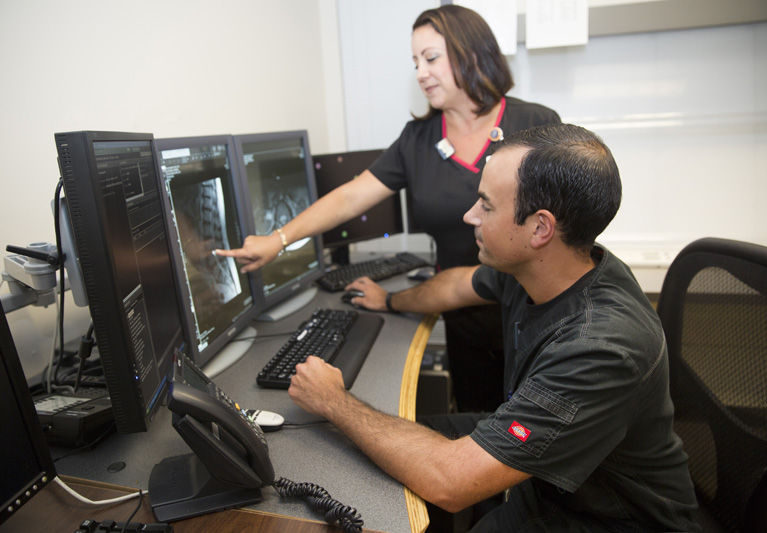
Sebastian River Medical Center will soon replace its 17-year-old magnetic resonance imaging machine, (MRI), with a new and significantly enhanced “Magnetom Aera” unit from Siemens, a move that will dramatically upgrade the capabilities of the hospital’s imaging department.
The new, ultra-sophisticated half-ton device – with a seven-figure price tag – will be delivered and installed at the hospital this August.
According to SRMC’s director of imaging services, Matt McGill, “We’re now going to be offering services on a par with hospitals twice our size.”
According to Medical News Today, an MRI machine uses a magnetic field and radio waves to take precise pictures of the organs and various skeletal, tissue and muscular support structures inside the body.
A strong magnetic field, created by passing electric current through a series of wire loops, triggers protons within the body to align. Radio waves are then absorbed by those protons, which in turn emit signals that are picked up by the machine’s sensors. That information is then sent to a computer which processes the signals and generates an image. The final product is a three dimensional representation of the area being examined.
Often, MRI scans show problems that cannot be detected or adequately viewed through x-rays, ultrasound or CT scans. Those problems can include tumors, internal bleeding and injuries, torn ligaments, blood vessel diseases, infections, brain aneurysms, signs of stroke and inflammation of the spine.
Usually done in conjunction with the some or all of the above imaging techniques, MRI scans can provide physicians with invaluable “inside information” for diagnosing and treating patients.
Jenifer Baumgardner of the hospital’s MRI department says the new device has a slew of advanced features. Perhaps the most impressive of those is the ability to scan patients who have certain types of pacemakers or heart defibrillators. That, claims Baumgardner, is a significant plus. Until quite recently people with life-extending implants such as pacemakers could not undergo an MRI due to electrical and magnetic conflicts. Now, says Baumgardner, people with certain Medtronic and Saint Jude Medical implants can safely undergo an MRI.
The effervescent Baumgardner also points to software advances incorporated into the Siemens unit that will allow people with joint replacements to get cleaner, sharper MRI scans than was previously possible. The new software, claims Baumgardner, can now “block-out” or at least radically reduce the distortions those prosthetics often cause.
Both McGill and Baumgardner also tout the wider “bore” or opening of the new MRI machine. With a patient compartment that’s 70 centimeters wide – or about 2.3 feet – it is a full four inches wider than the current machine. While four inches may not seem like a lot, those extra four inches can make a big difference to patients inclined to even moderate forms of claustrophobia,
According to the Shields Health Care Group, the 70 centimeter “wide bore” MRI actually, “provides more headroom than a so-called open MRI.” It is not open on the sides, but, they claim, “it is actually much more spacious.”
McGill adds that with the new Siemens machine, “We can do scans with people going in feet-first instead of head-first.”
As with any high-tech product purchase, having a self-professed research “geek” helping to crunch the numbers can smooth the process, and Baumgardner happily stepped into that role for McGill and SRMC on this purchase.
The new MRI is powered by a 1.5 Tesla – or 1.5-T – magnet. Its predecessor has a 1.01-T magnet.
There are even larger magnets on the MRI market today including a 3.0-T version but while those more powerful magnets can help produce still sharper images, many people who can be safely scanned by a 1.5-T magnet may face problems with a 3-T version.
At the same time, the 3-T MRIs are approximately twice the price of those performed by the SRMC’s incoming machine. Since Medicare, Medicaid and most insurance companies have set MRI price limits, there were financial considerations as well as technical ones involved in the decision-making process.
While McGill claims the new MRI may help eliminate the need for so-called “exploratory surgeries,” Baumgardner puts things in even simpler terms. With a big smile on her face she says SRMC will now be offering, “one stop shopping for imaging “on the Treasure Coast.
According to McGill, the new MRI will arrive in Sebastian on Aug. 26 and will be fully operable within one week of that date.



